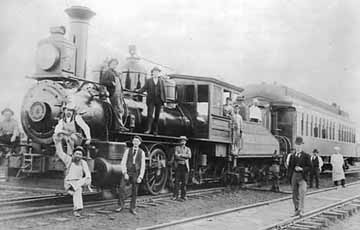 Illiopolis
Business Association
Illiopolis
Business Association 
Return to Centennial History Index
 Illiopolis
Business Association
Illiopolis
Business Association 
Local History
ILLIOPOLIS AND THE WABASH RAILROAD

This is a 1901 Decatur Herald and Review Photo of a Wabash train that probably passed through Illiopolis.
Governor
Joseph Duncan, in 1834, succeeded in forcing approval of a steam engine
railroad to be built between Quincy, on the Mississippi River, via Clayton, Mt.
Sterling, Meredosia, Jacksonville, Springfield, and Decatur to Danville
and the Illinois-Indiana State Line and the new railroad was to be built with
State funds.
This new railroad was
known as the "Northern Cross," a name chosen according to some
historians, because of the line surveyed for the railroad closely paralleled a
well-known trail known as the "Northern Crossing" of Illinois and
often called "Northern Cross" although it was actually in the south
central part of the state. It was
the only segment of the ambitious Internal Improvement Act to become a
reality. In 1842 a line between
Jacksonville and Springfield was completed, and in May 1842, service from
Meredosia to Springfield was made available.
The drama of the
building of the Northern Cross Railroad is the first chapter in the
romantic story that is the growth of the Wabash Railway system, for the lineage
of the Wabash can be traced, without a break, to the first 12-mile strip over
which the engineer Fields operated a clumsy little locomotive between Meredosia
and Morgan City in the fall of 1838.
The year 1847 saw the
first change in the new system that was soon to become known as the Wabash.
The legislature of the State of Illinois authorized the sale of the
original track between Meredosia and Springfield.
Nicholas H. Ridgeley was the purchaser.
He paid the sum of $21,000 for the road, changing its name to the Sangamon
and Morgan Railroad.
Ridgeley's purchases
turned out well, for at the time the extension of the road from Springfield-to
the Illinois Indiana State line had been temporarily abandoned by the state
because of lack of fund, and a short time after his original buy, he was granted
an extension of his charter, to include the entire length of the Northern
Cross.
Together with his new
partners, Nicholas Ridgeley pushed the rehabilitation of the line between
Springfield and the Illinois-Indiana state line. Already railroad traffic was mounting in the East, and plans
were underway for rapid extension of the Eastern roads to top the rapid
developing states of Illinois and Missouri.
Subsequently, on
February 12, 1853, the name was changed to the Great Western Railroad of
Illinois and trains started operating into Decatur on May 9, 1854. In the spring
of 1855 the Sangamon River was bridged and the road completed eastward,
the first train arriving at Danville, Illinois, in November 1856.
The Great Western
Railway of Illinois was to connect at the Illinois-Indiana line with a line
westward from Toledo across Indiana to the border. However, progress was slow and in 1857 another series of
"trades" changed the membership of the trackage that is now known as the
Wabash.
During its entire
period of expansion east of the Mississippi River, the Wabash system served as
the principal artery tapping the great "Heart of America." Other rail,
roads entered the Illinois-Indiana Territory, but these rail, roads moved only
toward the most important cities and the vast, undeveloped regions which today
are the most productive sections of the great "Heart" were accessible
only over the tracks of the Wabash.
In 1879 the Wabash
Railroad Company operating east of the Mississippi and the St. Louis, Kansas
City and Northern, operating west of the Mississippi were merged into the
Wabash, St. Louis and Pacific Railroad Company.
In 1889, both lines
east and west of the Mississippi were again reorganized, this time as the Wabash
Railroad Company.
Now 100% dieselized
for both passenger and freight service, and upholding its promise of ever better
service to the Heart of America, the Wabash again stands on the threshold of a
bright, successful future. Quoted
from an historical account compiled by Mr. Clyde M. Betts, ticket clerk
in the Wabash passenger station, Decatur, Illinois.
From Revised
Ordinances of the Village of Illiopolis, 1903
Ordinance
No. 16. Section 1. The rate of speed of passenger trains within the corporate
limits of the Village is limited to twelve miles per hour and the rate of speed
of all other trains, locomotives, engines or cars is limited to seven miles per
hour and any railroad corporation or conductor, engineer or other employee of
any railroad corporation or other person managing or controlling any trains,
locomotives engine or car at a greater rate of speed than above provided upon
any railroad track within the corporate limits of the Village shall be subject
to a penalty of not less than five dollars nor more than one hundred